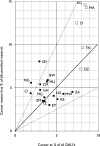Cancer research across Africa: a comparative bibliometric analysis
- PMID: 36356985
- PMCID: PMC9660667
- DOI: 10.1136/bmjgh-2022-009849
Cancer research across Africa: a comparative bibliometric analysis
Abstract
Introduction: Research is a critical pillar in national cancer control planning. However, there is a dearth of evidence for countries to implement affordable strategies. The WHO and various Commissions have recommended developing stakeholder-based needs assessments based on objective data to generate evidence to inform national and regional prioritisation of cancer research needs and goals.
Methodology: Bibliometric algorithms (macros) were developed and validated to assess cancer research outputs of all 54 African countries over a 12-year period (2009-2020). Subanalysis included collaboration patterns, site and domain-specific focus of research and understanding authorship dynamics by both position and sex. Detailed subanalysis was performed to understand multiple impact metrics and context relative outputs in comparison with the disease burden as well as the application of a funding thesaurus to determine funding resources.
Results: African countries in total published 23 679 cancer research papers over the 12-year period (2009-2020) with the fractional African contribution totalling 16 201 papers and the remaining 7478 from authors from out with the continent. The total number of papers increased rapidly with time, with an annual growth rate of 15%. The 49 sub-Saharan African (SSA) countries together published just 5281 papers, of which South Africa's contribution was 2206 (42% of the SSA total, 14% of all Africa) and Nigeria's contribution was 997 (19% of the SSA total, 4% of all Africa). Cancer research accounted for 7.9% of all African biomedical research outputs (African research in infectious diseases was 5.1 times than that of cancer research). Research outputs that are proportionally low relative to their burden across Africa are paediatric, cervical, oesophageal and prostate cancer. African research mirrored that of Western countries in terms of its focus on discovery science and pharmaceutical research. The percentages of female researchers in Africa were comparable with those elsewhere, but only in North African and some Anglophone countries.
Conclusions: There is an imbalance in relevant local research generation on the continent and cancer control efforts. The recommendations articulated in our five-point plan arising from these data are broadly focused on structural changes, for example, overt inclusion of research into national cancer control planning and financial, for example, for countries to spend 10% of a notional 1% gross domestic expenditure on research and development on cancer.
Keywords: cancer; health services research.
© Author(s) (or their employer(s)) 2022. Re-use permitted under CC BY. Published by BMJ.
Conflict of interest statement
Competing interests: None declared.
Figures








References
-
- De Gruyter Mouton . The languages and linguistics of Africa, 2018.
-
- Anyamele OD, Ukawuilulu JO, Akanegbu BN. The Role of Wealth and Mother’s Education in Infant and Child Mortality in 26 Sub-Saharan African Countries: Evidence from Pooled Demographic and Health Survey (DHS) Data 2003–2011 and African Development Indicators (ADI), 2012. Soc Indic Res 2017;130:1125–46. 10.1007/s11205-015-1225-x - DOI
Publication types
MeSH terms
Grants and funding
LinkOut - more resources
Full Text Sources
Medical
Research Materials
